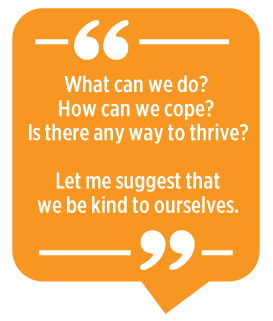|
 When the
world shut down in March because of COVID-19, we all expected to be back to
normal by September, didn’t we? For some of you, that reality is close. You may
be more cautious in your social or workplace face-to-face interactions, but you
are no longer sheltering at home or avoiding trips to the store, the doctor, or
your favorite restaurant. But many are not yet back to normal, although none of
us want this state of affairs to turn into a new normal.
When the
world shut down in March because of COVID-19, we all expected to be back to
normal by September, didn’t we? For some of you, that reality is close. You may
be more cautious in your social or workplace face-to-face interactions, but you
are no longer sheltering at home or avoiding trips to the store, the doctor, or
your favorite restaurant. But many are not yet back to normal, although none of
us want this state of affairs to turn into a new normal.
An analogy
for the United States, Brazil, India, and other countries where coronavirus
cases are rising might be this: The light at the end of the tunnel is not the
exit but an oncoming train. We continue to not know what to expect. The danger
isn’t gone. We can’t fix our economy without getting a grip on the virus. We
can’t fix our schools without getting a grip on the virus. We can’t travel to
visit our loved ones without getting a grip on the virus.
What can we
do? How can we cope? Is there any way to thrive? Let me suggest that we be kind
to ourselves. That we take care of ourselves.
We are
weathering the COVID-19 storm; we are learning how to help ourselves, our
colleagues, and our English learners every day. I’m sure you have been busy
these past few months exploring better ways to teach remotely and figuring out
how to go back to face-to-face instruction safely, if only for part of an
academic week. You’ve been redesigning your curriculum and revising your
assessments for an online world.
 Educators
are essential workers. You are an essential worker. Our students and their
parents rely on us. They expect us to be present, ever striving to instill
knowledge. But just like we tell new teachers “chunk and chew”—teach for 10
minutes and let students process for two—we need regular breaks to refresh and
regroup as well. Educators
are essential workers. You are an essential worker. Our students and their
parents rely on us. They expect us to be present, ever striving to instill
knowledge. But just like we tell new teachers “chunk and chew”—teach for 10
minutes and let students process for two—we need regular breaks to refresh and
regroup as well.
I thought I
would do a lot of pleasure reading after things shut down in March. Ha! I
couldn’t escape into fantasy or historical fiction. The real world was already
a dystopian, surreal environment. I was reading daily, yes, but it was news
reports and technical guidelines for apps like Zoom. I was staring at a screen
for hours and hours each day and couldn’t stare at a book at the end of an
evening. I was tense, worried, unsure.
Recently,
though, I made the decision to carve out time each day for non-work-related
reading. I just finished a book, Painting
Harlem Modern: The Art of Jacob Lawrence by Patricia
Hills. I had the book prepandemic, but it lay on my living room table for
months. I finally picked it up last week and found joy. No—really. Gazing at
Jacob Lawrence’s vibrant paintings let me imagine I was in a museum, following
his narrative path in the Toussaint L’Ouverture, the Harriet Tubman, the Great
Migration, and the life in Harlem series, among his other works of art. And
while the social commentary of his paintings is pertinent to today’s time and
troubles, the strength and universality of his images was rejuvenating and
engaging.
For many of
us, the academic year is starting. It’s busy, it’s stressful, it’s unknown.
There’s hardly time to take a breath. But do so, for yourself and your
students. Take time for self-care. Find an activity to enjoy. Find a friend to
share the experience with, even if it is a recounting done from a distance.
Exercise, dance, sing, write, sew, sketch, or cook. Find moments of
peace.
Deborah J. Short, PhD, is TESOL International Association president (2020–2021). She directs Academic Language Research & Training, LLC and provides professional development on academic literacy, content-based ESL, and sheltered instruction worldwide. She has led numerous research projects related to English learner education, codeveloped the SIOP Model, and served as series editor for several 6 Principles books. |